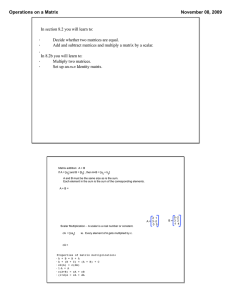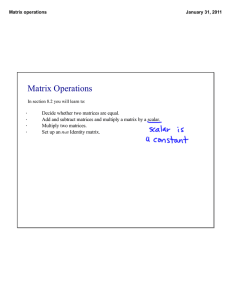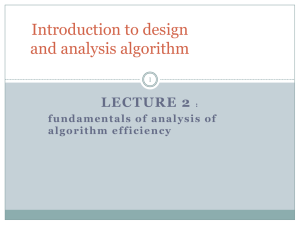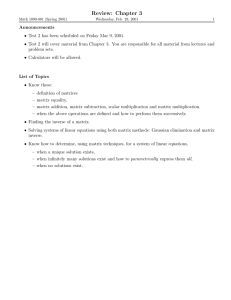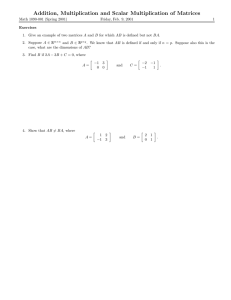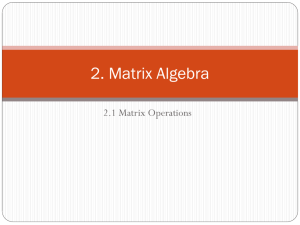محاضرات الأسبوع الأول والثانى جبر خطى
advertisement
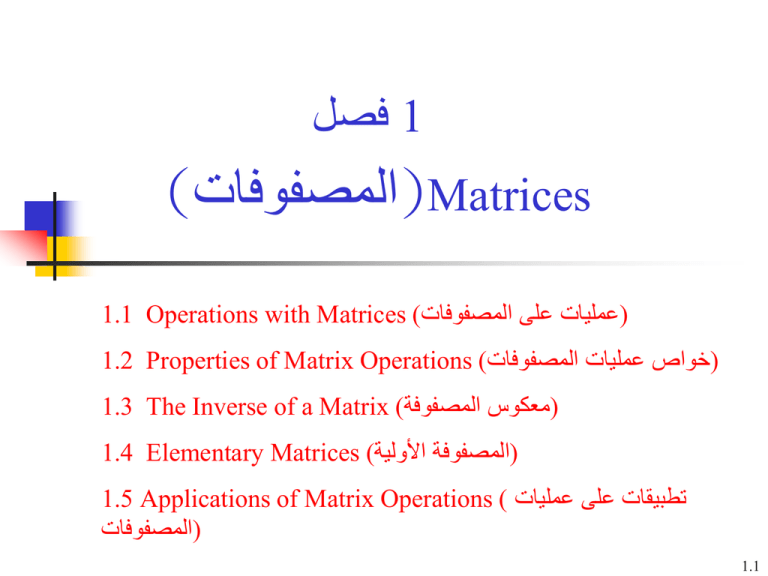
فصل1 ()المصفوفاتMatrices 1.1 Operations with Matrices ()عمليات على المصفوفات 1.2 Properties of Matrix Operations ()خواص عمليات المصفوفات 1.3 The Inverse of a Matrix ()معكوس المصفوفة 1.4 Elementary Matrices ()المصفوفة األولية 1.5 Applications of Matrix Operations ( تطبيقات على عمليات )المصفوفات 1.1 1.1 Operations with Matrices ()عمليات على المصفوفات Matrix: a11 a12 a13 a1n a a a a 22 23 2n 21 A [aij ] a31 a32 a33 a3n M mn am1 am 2 am3 amn mn (i, j)-th entry (or element): aij number of rows ()عدد الصفوف: m number of columns ()عدد األعمدة: n Size ()مقاس أو بعد: m×n Square matrix ()مصفوفة مربعه: m =n 1.2 Equal matrices ()المصفوفات المتساوية: two matrices are equal if they have the same size (m × n) and entries corresponding to the same position are equal For A [aij ]m n and B [bij ]m n , A B if and only if aij bij for 1 i m, 1 j n Ex 1: Equality of matrices ()تساوى المصفوفات 1 2 A 3 4 a b B c d If A B, then a 1, b 2, c 3, and d 4 1.3 Matrix addition ()جمع المصفوفات: If A [aij ]m n , B [bij ]m n , then A B [aij ]mn [bij ]mn [aij bij ]mn [cij ]mn C Ex 2: Matrix addition ()جمع المصفوفات: 1 2 1 3 1 1 2 3 0 5 0 1 1 2 0 1 1 2 1 3 1 1 3 3 2 2 1 1 0 3 3 0 2 2 0 1.4 Scalar multiplication ()الضرب المصفوفه في ثابت قياسي: If A [aij ]m n and c is a constant scalar, then cA [caij ]m n Matrix subtraction ()طرح المصفوفات:: A B A (1) B Ex 3: Scalar multiplication and matrix subtraction 1 2 4 A 3 0 1 2 1 2 0 0 2 B 1 4 3 3 2 1 Find (a) 3A, (b) –B, (c) 3A – B 1.5 Sol: (a) (b) (c) 1 2 4 31 32 34 3 6 12 3A 3 3 0 1 3 3 30 3 1 9 0 3 6 2 1 2 32 31 32 6 3 0 0 0 0 2 2 4 3 B 1 1 4 3 1 3 2 1 3 2 1 0 0 1 6 12 3 6 12 2 3 A B 9 0 3 1 4 3 10 4 6 4 6 1 3 2 7 0 6 3 1.6 Matrix multiplication ()ضرب المصفوفات: If A [aij ]m n and B [bij ]n p , then AB [aij ]m n [bij ]n p [cij ]m p C , should be equal size of C=AB n where cij aik bkj ai1b1 j ai 2b2 j ainbnj k 1 a11 a12 a1n b b b1n 11 1j b b b 21 2j 2n ai1 ai 2 ain ci1 ci 2 cij cin bn1 bnj bnn an1 an 2 ann ※ The entry cij is obtained by calculating the sum of the entry-by-entry product between the ith row of A and the jth column of B 1.7 Ex 4: Find AB 1 3 3 2 A 4 2 B 4 1 2 2 5 0 3 2 Sol: (1)(3) (3)(4) (1)(2) (3)(1) AB (4)(3) (2)(4) (4)(2) (2)(1) (5)(3) (0)(4) (5)(2) (0)(1) 3 2 9 1 4 6 15 10 3 2 Note: (1) BA is not multipliable غير قابلة للضرب (2) Even BA is multipliable قابلة للضربBA حتى لو أن, AB≠BA 1.8 Matrix form of a system of linear equations in n variables الشكل المصفوفى لنظام المعادالت الخطيه: a11 x1 a12 x2 a1n xn b1 a x a x a x b 21 1 22 2 2n n 2 m linear equations am1 x1 am 2 x2 amn xn bm a11 a12 a1n x1 b1 a x b a a 22 2n 2 21 2 a a a m2 mn xn m1 bm = = = A x b single matrix equation A xb m n n 1 m 1 1.9 Trace operation ( )أثر المصفوفةTr(A): If A [aij ]n n , then Tr ( A) a11 a22 Tr (A T ) Tr (A ); Tr (AB ) Tr (BA ); ann Tr (A B ) Tr (A ) Tr (B ) Tr (kB ) kTr (A ) Diagonal matrix ()المصفوفه القطريه: a square matrix in which nonzero elements are found only in the principal diagonal d1 0 0 d 2 A diag (d1 , d 2 ,, d n ) 0 0 0 0 M nn d n ※ It is the usual notation for a diagonal matrix. 1.10 1.2 Properties of Matrix Operations ()خواص عمليات المصفوفات Three basic matrix operators, introduced in Sec. 1.1: (1) matrix addition (2) scalar multiplication (3) matrix multiplication Zero matrix ()المصفوفه الصفريه: 0mn 0 0 0 0 0 0 Identity matrix of order n ()مصفوفة الوحدة: 0 0 0 mn 1 0 0 1 In 0 0 0 0 1 n n 1.11 Properties of matrix addition and scalar multiplication: If A, B, C M mn , and c, d are scalars, then (1) A+B = B+A (Commutative property of addition) ()األبدال (2) A+(B+C) = (A+B)+C (3) ( cd ) A = c ( dA ) (4) 1A = A (Associative property of addition) ()الدمج (Associative property of scalar multiplication) (Multiplicative identity property, and 1 is the multiplicative identity for all matrices) (5) c( A+B ) = cA + cB (6) ( c+d ) A = cA + dA (Distributive property of scalar multiplication over matrix addition) ()التوزيع عند الضرب فى ثابت (Distributive property of scalar multiplication over real-number addition) حيثc, d )أعداد حقيقيه (ثوابت 1.12 Properties of zero matrices ()خواص المصفوفه الصفرية: If A M mn , and c is a scalar, then (1) A 0mn A ※ So, 0m×n is also called the additive identity for the set of all m×n matrices (2) A ( A) 0mn ※ Thus , –A is called the additive inverse of A (3) cA 0mn c 0 or A 0mn 1.13 Properties of matrix multiplication ()خواص ضرب المصفوفات: (1) A(BC) = (AB ) C (Associative property of matrix multiplication) ()الدمج (2) A(B+C) = AB + AC (Distributive property of LHS matrix multiplication over matrix addition) (Distributive property of RHS matrix multiplication over matrix addition) (3) (A+B)C = AC + BC (4) c (AB) = (cA) B = A (cB) ※ For real numbers, the properties (2) and (3) are the same. Properties of the identity matrix ()خواص مصفوفة الوحدة: : If A M mn , then (1) AI n A (2) I m A A ※ For real numbers, the role of 1 is similar to the identity matrix. However, 1 is unique for real numbers and there could be many identity matrices with different sizes 1.14 Ex 3: Matrix Multiplication is Associative ()ضرب المصفوفات دامج Calculate (AB)C and A(BC) for 1 2 1 0 2 A , B , 2 1 3 2 1 Sol: 1 ( AB )C 2 5 1 1 0 and C 3 1 . 2 4 1 2 1 0 2 3 1 3 2 1 2 1 0 4 0 17 3 1 2 3 13 2 4 0 1 4 4 14 1.15 1 A( BC ) 2 1 2 2 1 1 3 2 3 1 7 1 0 0 2 3 1 2 1 2 4 8 17 4 2 13 14 1.16 Definition of Ak : repeated multiplication of a square matrix: A1 A, A2 AA, , Ak AA A k matrices Properties for Ak: (1) AjAk = Aj+k (2) (Aj)k = Ajk where j and k are nonnegative ( )غير سالبهintegers and A0 is assumed to be I For diagonal matrices فقط للمصفوفة القطرية: d1 0 0 d 2 D 0 0 0 d1k 0 0 k D dn 0 0 d 2k 0 0 0 d nk 1.17 Transpose of a matrix ()مدور (منقول) المصفوفة: a11 a12 a a22 21 If A am1 am 2 a11 a then AT 12 a1n a21 a22 a2 n a1n a2 n M mn , amn am1 am 2 M n m amn ※ The transpose operation is to move the entry aij (original at the position (i, j)) to the position (j, i) ※ Note that after performing the transpose operation, AT is with the size n×m 1.18 Ex 8: Find the transpose of the following matrix أوجد مدور المصفوفات 2 (a) A 8 Sol: (a) (b) 1 2 3 A 4 5 6 7 8 9 2 A AT 2 8 (b) 1 2 3 1 A 4 5 6 AT 2 7 8 9 3 (c) 1 0 0 A 2 4 AT 1 1 1 1 0 (c) A 2 4 1 1 8 4 7 5 8 6 9 2 1 4 1 1.19 Properties of transposes ())خواص على المدور (المنقول: (1) ( AT )T A (2) ( A B)T AT BT (3) (cA)T c( AT ) (4) ( AB)T BT AT ※ Properties (2) and (4) can be generalized to the sum or product of multiple matrices. For example, (A+B+C)T = AT+BT+CT and (ABC)T = CTBTAT 1.20 Ex 9: Show that (AB)T and BTAT are equal 1 2 2 A 1 0 3 0 2 1 3 1 B 2 1 3 0 Sol: T 2 1 2 3 1 2 1 2 6 1 T ( AB) 1 0 3 2 1 6 1 1 1 2 0 2 1 3 0 1 2 T 2 1 0 3 2 3 2 6 1 T T B A 1 0 2 1 1 0 1 1 2 2 3 1 1.21 Symmetric matrix ()مصفوفة متماثلة: A square matrix A is symmetric if A = AT Skew-symmetric matrix ()مصفوفة متماثلة تخالفيا: : A square matrix A is skew-symmetric if AT = –A Ex: 1 2 3 If A a 4 5 is symmetric, find a, b, c? b c 6 Sol: 1 2 3 1 a b T A A A a 4 5 AT 2 4 c a 2, b 3, c 5 b c 6 3 5 6 1.22 Ex: 0 1 2 If A a 0 3 is a skew-symmetric, find a, b, c? b c 0 Sol: 0 a b 0 1 2 A a 0 3 AT 1 0 c b c 0 2 3 0 A AT a 1, b 2, c 3 Note: AAT must be symmetric Pf: ( AAT )T ( AT )T AT AAT AA is symmetric T ※ The matrix A could be with any size, i.e., it is not necessary for A to be a square matrix. ※ In fact, AAT must be a square matrix. 1.23 Before finishing this section, two properties will be discussed, which is held for real numbers, but not for matrices: the first is the commutative property of matrix multiplication and the second is the cancellation law ()قانون الحذف Real number ()االبدال متوفر فى األعداد الحقيقيه: ab = ba (Commutative property of real-number multiplication) Matrix ()االبدال غير متوفر فى المصفوفات: : AB BA m n n p n p m n Three situations for BA: ( 1) If m p , then AB is defined, but BA is undefined ( 2) If m p, m n, then AB M mm , BA M nn (Sizes are not the same) (3) If m p n, then AB M mm, BA M mm (Sizes are the same, but resultant matrices are not equal) 1.24 Ex 4: AB BA بين أن Sow that AB and BA are not equal for the matrices. 2 1 1 3 B A and 0 2 2 1 Sol: 5 1 3 2 1 2 AB 2 1 0 2 4 4 7 2 1 1 3 0 BA 0 2 2 1 4 2 AB BA (noncommutativity of matrix multiplication) 1.25 Notes: (1) A+B = B+A (the commutative law of matrix addition) (2) AB BA (the matrix multiplication is not with the commutative law) (so the order of matrix multiplication is very important) ()الترتيب فى الضرب مهم جدا 1.26 Real number لألعداد الحقيقية: ac bc, c 0 (Cancellation law for real numbers) a b Matrix ()قانون الحذف فى المصفوفات: AC BC and C 0 (C is not a zero matrix) (1) If C is invertible ()قابله للعكس, then A = B (2) If C is not invertible ()غير قابله للعكس, then A B (Cancellation law is not necessary to be valid) قانون الحذف ليس بالضرورة يكون متوفر 1.27 Ex 5: (An example in which cancellation is not valid) Show that AC=BC 1 3 2 4 1 2 A , B , C 0 1 2 3 1 2 Sol: 1 AC 0 2 BC 2 3 1 2 2 4 1 1 2 1 2 4 1 2 2 4 3 1 2 1 2 So, although AC BC , A B قانون الحذف فى المصفوفات ليس بالضروره يكون متوفر 1.28 2.3 The Inverse of a Matrix ()معكوس المصفوفة Inverse matrix: Consider A M nn , مصفوفة مربعه if there exists a matrix B M nn such that AB BA I n , then (1) A is invertible (or nonsingular) (2) B is the inverse of A B A 1 Note: A square matrix that does not have an inverse ()ليس لها معكوس is called noninvertible (or singular) ()غير قابله للعكس او شاذه 1.29 Theorem نظرية: The inverse of a matrix is unique If B and C are both inverses of the matrix A, then B = C معكوس المصفوفه وحيد. AB I Pf: C ( AB) CI (CA) B C IB C (associative property of matrix multiplication and the property for the identity matrix) BC Consequently, the inverse of a matrix is unique. معكوس المصفوفه وحيد Notes: (1) The inverse of A is denoted by A1 (2) AA1 A1 A I A1 هوA معكوس المصفوفة 1.30
